Developmental Characteristics of Post-Rift Faults and Palostress Field Inversion in the Bozhong 19-6 Structural Belt
Abstract
1. Introduction
2. Regional Tectonic Background
3. Method
3.1. The Growth Index
3.2. Inversion of Paleostress in Post-Rift Period
3.3. Data Collection and Processing
4. Results
4.1. Geometric Features
4.2. Kinematics Features
- (1)
- Newly formed faults
- (2)
- Long-term active faults
- (3)
- Dip-linked faults
4.3. Paleostress Inversion Results
5. Conclusions
- (1)
- In the study area, the predominant orientation of faults during the post-rift phase is east–west, followed by northeast–southwest. These faults are classified into three types based on their activity nature: newly formed faults, long-term active faults, and trend-connected faults. The latter two types represent faults that were active during the rifting phase and became reactivated during the post-rift phase.
- (2)
- This paper presents a paleostress inversion method based on seismic interpretation data and the slip tendency algorithm. The method utilizes seismic interpretation data to obtain geometric parameters of faults. By iteratively searching for the best match between slip tendency and fault throw distribution, it inverts the Neogene paleostress regime of the BZ19-6 block. This method overcomes the challenges of traditional paleostress inversion methods, such as difficulties in acquiring field outcrop data, complexity in operation, and limited applicability in oilfield settings.
- (3)
- The paleostress inversion results for the BZ19-6 block indicate a strike-slip stress regime, with the intermediate principal stress (σ2) vertical. The orientation of the minimum principal stress (σ3) is approximately N170°, while the orientation of the maximum principal stress (σ1) is approximately N80°. The ratios of σ3 to σ1 and σ2 to σ1 are 0.24 and 0.62, respectively. The inverted stress regime associated with recent tectonic movements is consistent with results obtained from rock fracturing experiments. This method demonstrates widespread applicability and scalability in the oil and gas industry, providing a basis for reservoir fracture prediction and petroleum exploration assessment.
Author Contributions
Funding
Data Availability Statement
Acknowledgments
Conflicts of Interest
References
- Xu, C.; Yu, H.; Wang, J.; Liu, X. Formation conditions and accumulation characteristics of Bozhong 19-6 large condensate gas field in offshore Bohai Bay Basin. Pet. Explor. Dev. 2019, 46, 25–38. [Google Scholar] [CrossRef]
- Li, W.; Deng, Y. Influence of Magmatic Activity on Hydrocarbon Accumulation in Bozhong 19-6 Buried-hill in Bohai Bay Basin. J. Tongji Univ. Nat. Sci. 2022, 50, 1052–1061. [Google Scholar] [CrossRef]
- Zhou, Q.; Liu, Y.; Wang, D.; Guan, Q.; Wang, G.; Wang, Y.; Li, Z.; Li, S. Mesozoic-Cenozoic tectonic evolution and buried hill formation in central Bohai Bay. Earth Sci. Front. 2022, 29, 147–160. [Google Scholar] [CrossRef]
- Wang, D.; Liu, X.; Deng, H.; Liu, Y.; Li, D. Characteristics of the Meso-Cenozoic tectonic transformation and its control on the formation of large-scale reservoirs in the Archean buried hills in Bozhong 19-6 area, Bohai Bay Basin. Oil Gas Geol. 2022, 43, 1334–1346. [Google Scholar]
- Zhang, Z.; Lin, W.; Guo, H.; Song, W.; Wang, Q. Tertiary fault-slip analysis and paleostress reconstruction of the kuqa depression, North Tarim Basin. Chin. J. Geol. 2004, 39, 496–506. [Google Scholar]
- Yan, S.; Zhang, B.; Zhang, J.; Wu, J.; Zhao, Z. Calcite twins as a tool for the estimation of paleostress orientation on the basis of Electron Backscatter Diffraction (EBSD) Technique. Geol. Sci. Technol. Inf. 2016, 35, 50–54. [Google Scholar]
- Li, Y.; Fukuyama, E.; Yoshimitsu, N. Mining-induced fault failure and coseismic slip based on numerical investigation. Bull. Eng. Geol. Environ. 2024, 83, 386. [Google Scholar] [CrossRef]
- Zhuang, X.; Zou, H.; Teng, C. Controlling of Hydrocarbons by Neotectonics and Tectonic Fault Activities: A Case Study of Bozhong Area. J. China Univ. Min. Technol. 2012, 41, 452–459. [Google Scholar]
- Liu, B.; He, S.; Meng, L.; Fu, X.; Gong, L.; Wang, H. Sealing Mechanisms in Volcanic Faulted Reservoirs in Xujiaweizi Extension, Northern Songliao Basin, Northeastern China. AAPG Bull. 2021, 105, 1721–1743. [Google Scholar] [CrossRef]
- Angelier, J. Determination of the mean principal directions of stresses for a given fault population. Tectonophysics 1979, 56, 17–26. [Google Scholar] [CrossRef]
- Etchecopar, A.; Vasseur, G.; Daignieres, M. An inverse problem in microtectonics for the determination of stress tensors from fault striation analysis. J. Struct. Geol. 1981, 3, 51–65. [Google Scholar] [CrossRef]
- Celerier, B. How much does slip on a reactivated fault plane constrain the stress tensor? Tectonics 1988, 7, 1257–1278. [Google Scholar] [CrossRef]
- Lisle, R.J. Simple graphical constructions for the direction of shear. J. Struct. Geol. 1998, 20, 969–973. [Google Scholar] [CrossRef]
- Yamaji, A. The multiple inverse method: A new technique to separate stresses from heterogeneous fault-slip data. J. Struct. Geol. 2000, 22, 441–452. [Google Scholar] [CrossRef]
- Hansen, J.A. Direct inversion of stress, strain or strain rate including vorticity: A linear method of homogenous fault–slip data inversion independent of adopted hypothesis. J. Struct. Geol. 2013, 51, 3–13. [Google Scholar] [CrossRef]
- Zhang, Z.; Wang, Y.; Li, J.; Liu, S.; Yun, J.; Li, J. Dynamic Evolution assessment of the Paleozoic hydrocarbon cap rocks in Bachu-Magati area, Tarim Basin. Oil Gas Geol. 2014, 35, 839–852. [Google Scholar]
- Fleischmann, K.H.; Nemcok, M. Paleostress inversion of fault/slip data using the shear stress solution of Means (1989). Tectonophysics 1991, 196, 195–202. [Google Scholar] [CrossRef]
- Fry, N. Striated faults: Visual appreciation of their constraint on possible palaeostress tensors. J. Struct. Geol. 1999, 21, 7–22. [Google Scholar] [CrossRef]
- Nemcok, M.; Kovac, D.; Lisle, R.J. A Stress inversion procedure for polyphase calcite twin and fault/slip data sets. J. Struct. Geol. 1999, 21, 597–611. [Google Scholar] [CrossRef]
- Lacombe, O. Paleostress magnitudes associated with development of mountain belts: Insights from tectonic analyses of calcite twins in the Taiwan Foothills. Tectonics 2001, 20, 834–849. [Google Scholar] [CrossRef]
- Lacombe, O. Calcite twins, a tool for tectonic studies in thrust belts and stable orogenic forelands. Oil Gas Sci. Technol. Rev. IFP Energ. Nouv. 2010, 65, 809–838. [Google Scholar] [CrossRef]
- Tourneret, C.; Laurent, P. Paleo-stress orientations from calcite twins in the North Pyrenean foreland, determined by the Etchecopar inverse method. Tectonophysics 1990, 180, 287–302. [Google Scholar] [CrossRef]
- Arboit, F.; Amrouch, K.; Collins, A.S.; King, R.; Morley, C. Determination of the tectonic evolution from fractures, faults, and calcite twins on the southwestern margin of the Indochina Block. Tectonics 2015, 34, 1576–1599. [Google Scholar] [CrossRef]
- Han, X.; Wang, C.; Liang, J.; Zhang, G.; Feng, Z.; Chen, M.; Liu, Z. The calcite e-twin as an application of analysis and determination of the orientation and magnitude of palaeostress in Guilin. In Proceedings of the Earth Sci. Resour. Environ. Proc. South China Youth Geoscience Symposium, Guilin, China, November 2003; pp. 39–42. [Google Scholar]
- Song, H. A graphic method for calculatingt the direction of the principal compressive stress from e twinning in calcite. Earth Sci. 1982, 3, 179–187. [Google Scholar]
- Köpping, J.; Peternell, M.; Prelević, D.; Rutte, D. Cretaceous tectonic evolution of the Sava-Klepa Massif, Republic of North Macedonia–Results from calcite twin based automated paleostress analysis. Tectonophysics 2019, 758, 44–54. [Google Scholar] [CrossRef]
- Zheng, J.; Shan, Y. Paleostress Analyses of Calcite e-twins: Theory and Prospect. Geotecton. Metallogen. 2020, 44, 47–56. [Google Scholar]
- Mcfarland, J.M.; Morris, A.P.; Ferrill, D.A. Stress inversion using slip tendency. Comput. Geosci. 2012, 41, 40–46. [Google Scholar] [CrossRef]
- Ping, G.; Liu, X.; Li, M.; Zhang, X.; Gao, Y.; Wang, S.; Liu, X. Using Seismic Data and Slip Tendency to Estimate Paleostress: A Case Study From Xicaogu Area of Bohai Bay Basin, China. Front. Earth Sci. 2022, 10, 812874. [Google Scholar] [CrossRef]
- Morris, A.P.; Ferrill, D.A.; McGinnis, R.N. Using fault displacement and slip tendency to estimate stress states. J. Struct. Geol. 2016, 83, 60–72. [Google Scholar] [CrossRef]
- Morris, A.; Ferrill, D.A.; Henderson, D.B. Slip-tendency analysis and fault reactivation. Geology 1996, 24, 275–278. [Google Scholar] [CrossRef]
- Baudon, C.; Cartwright, J. The kinematics of reactivation of normal faults using high resolution throw mapping. J. Struct. Geol. 2008, 30, 1072–1084. [Google Scholar] [CrossRef]
- Pochat, S.; Castelltort, S.; Choblet, G.; Van Den Driessche, J. High-resolution record of tectonic and sedimentary processes in growth strata. Mar. Pet. Geol. 2009, 26, 1350–1364. [Google Scholar] [CrossRef]
- Wang, H.; Fu, X.; Wang, H.; Chen, M.; Meng, L.; Ping, G. Research on the controlling effect of quantitative analysis and evaluation of fault activity on oil and gas accumulation in Qikou sag of Bohai Bay Basin. Acta Geol. Sin. 2020, 94, 3062–3073. [Google Scholar] [CrossRef]
- Zhou, C.; Geng, Y.; Lei, Y.; He, Y. Experimental research on distribution of in-situ stress of Bozhong 19-6 complex fault block structure. Petrochem. Ind. Appl. 2020, 39, 84–89. [Google Scholar]
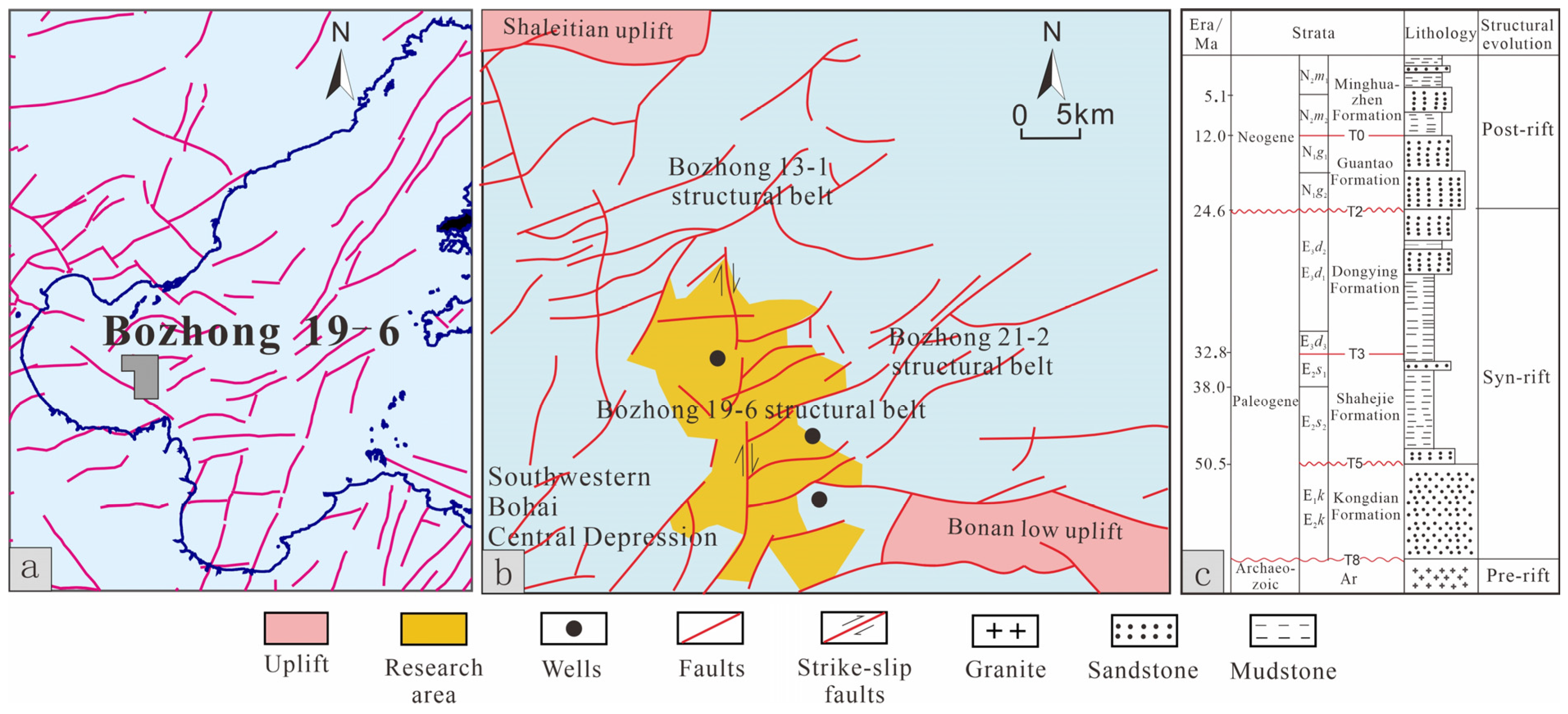
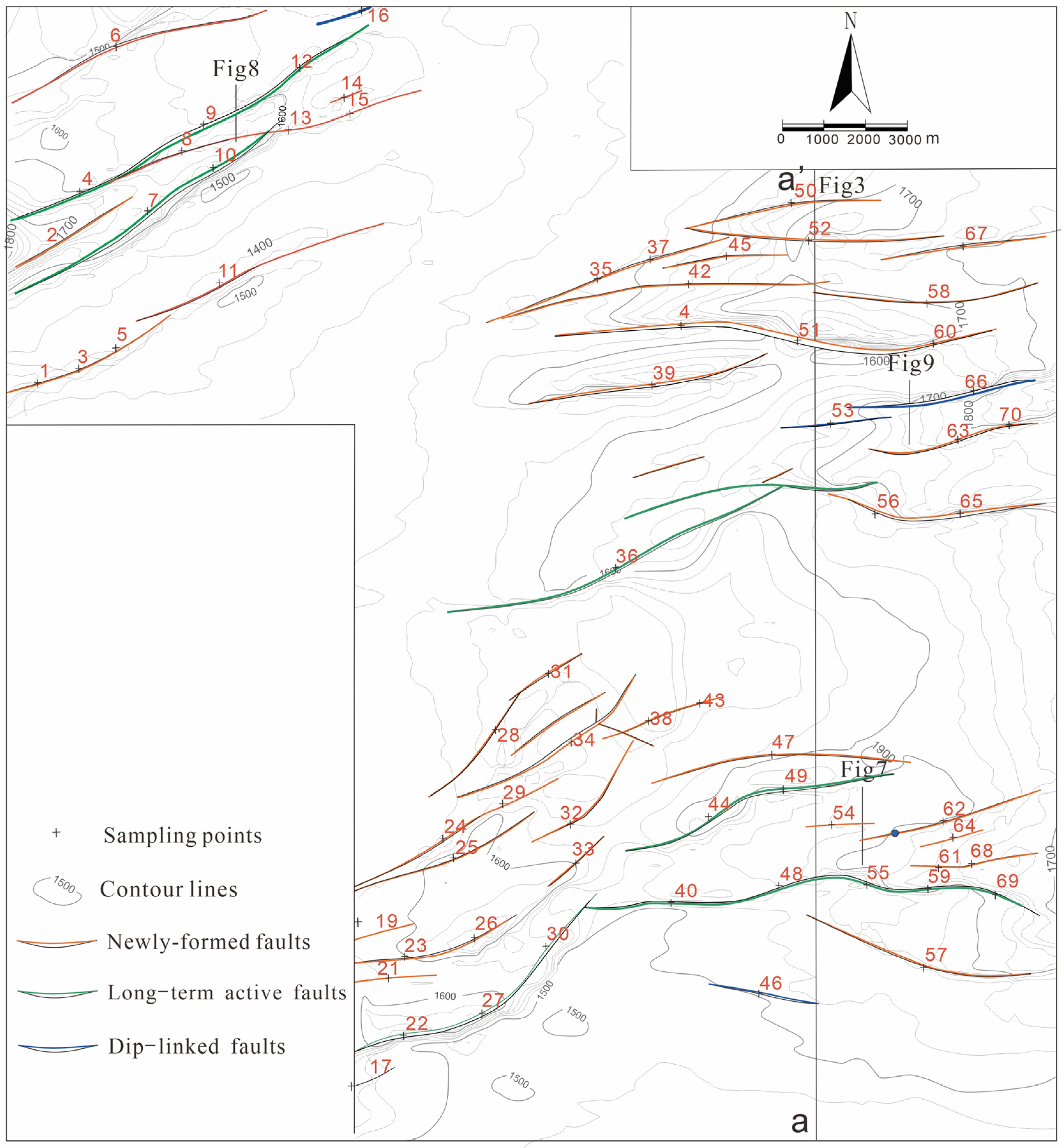
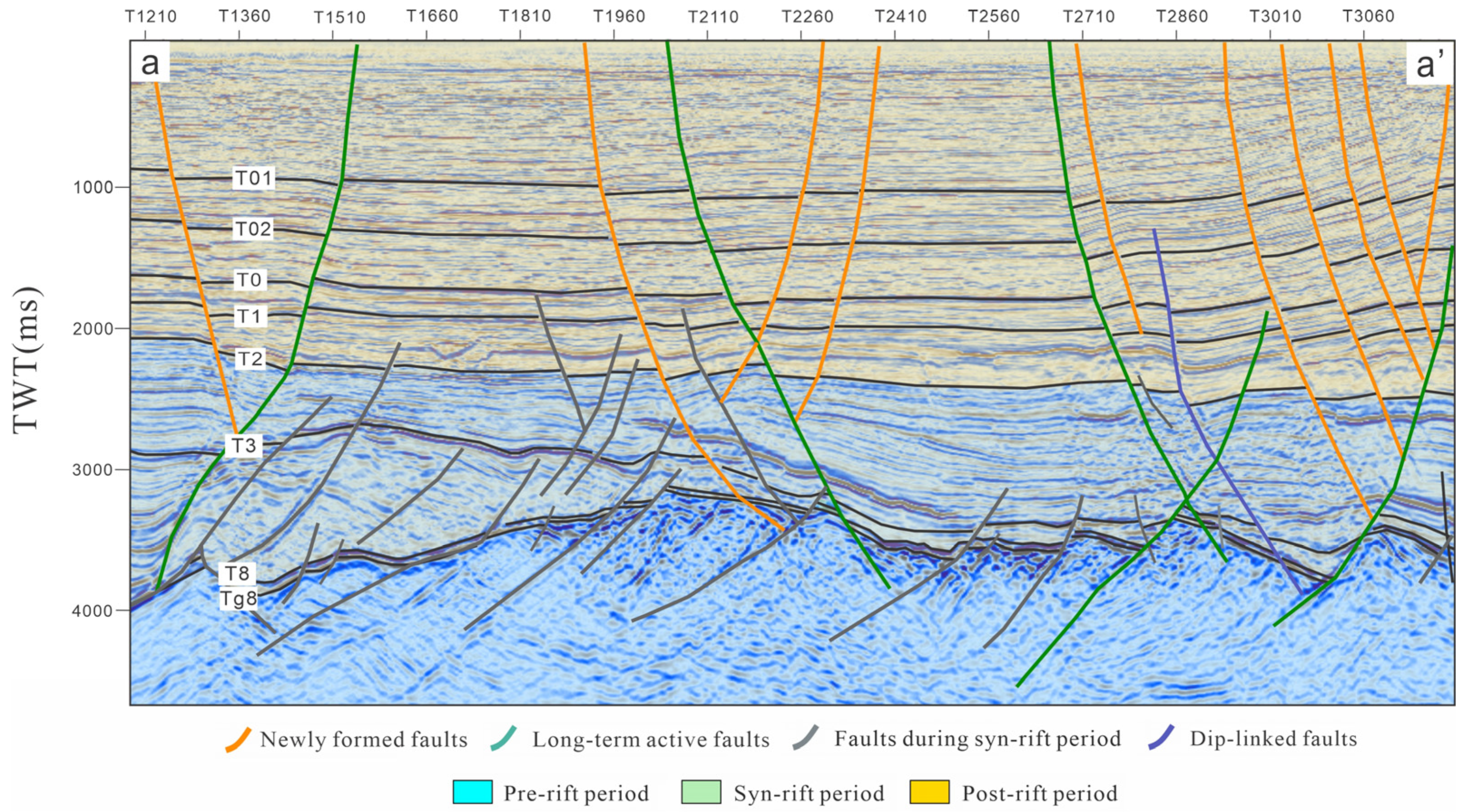
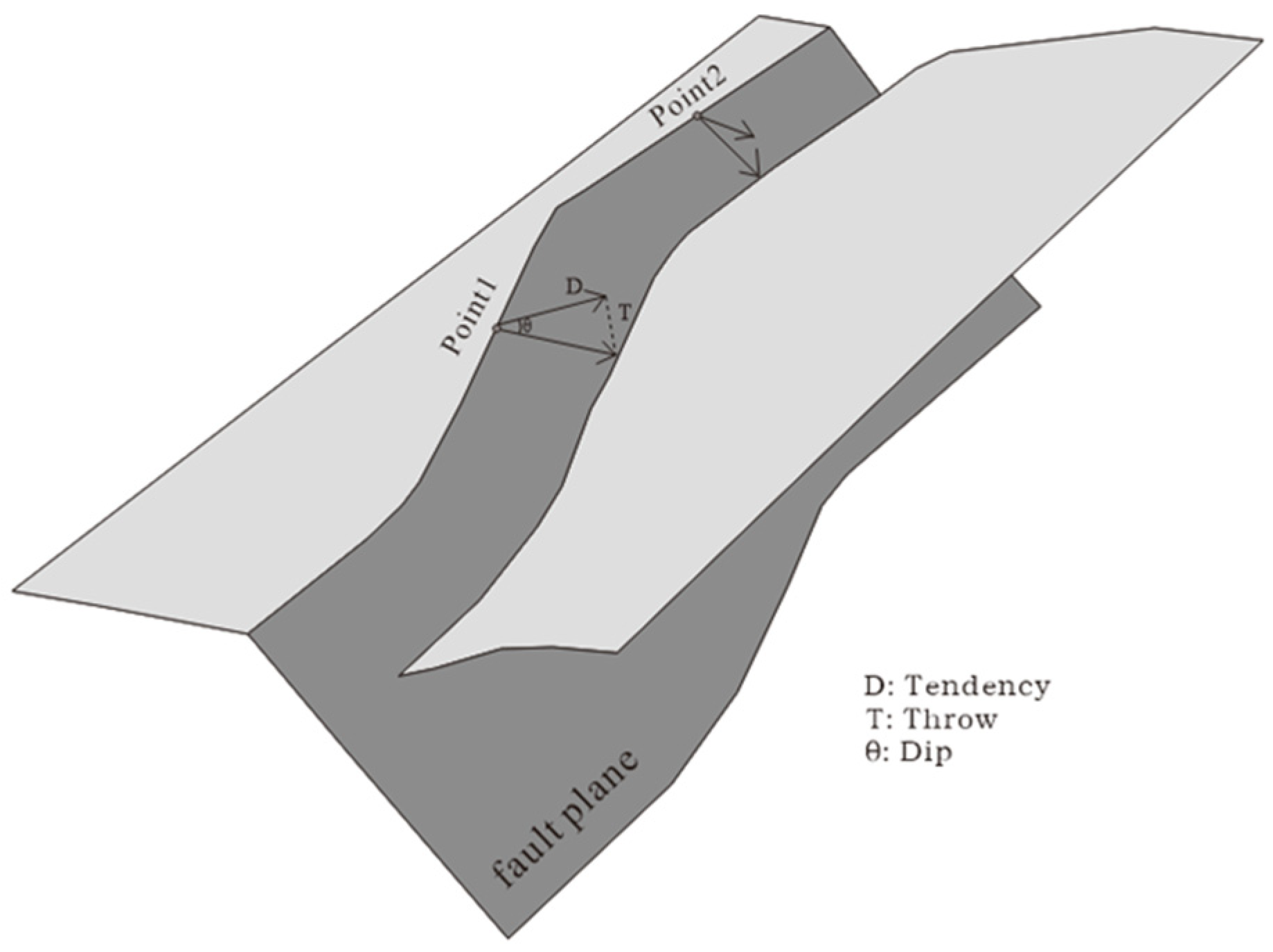
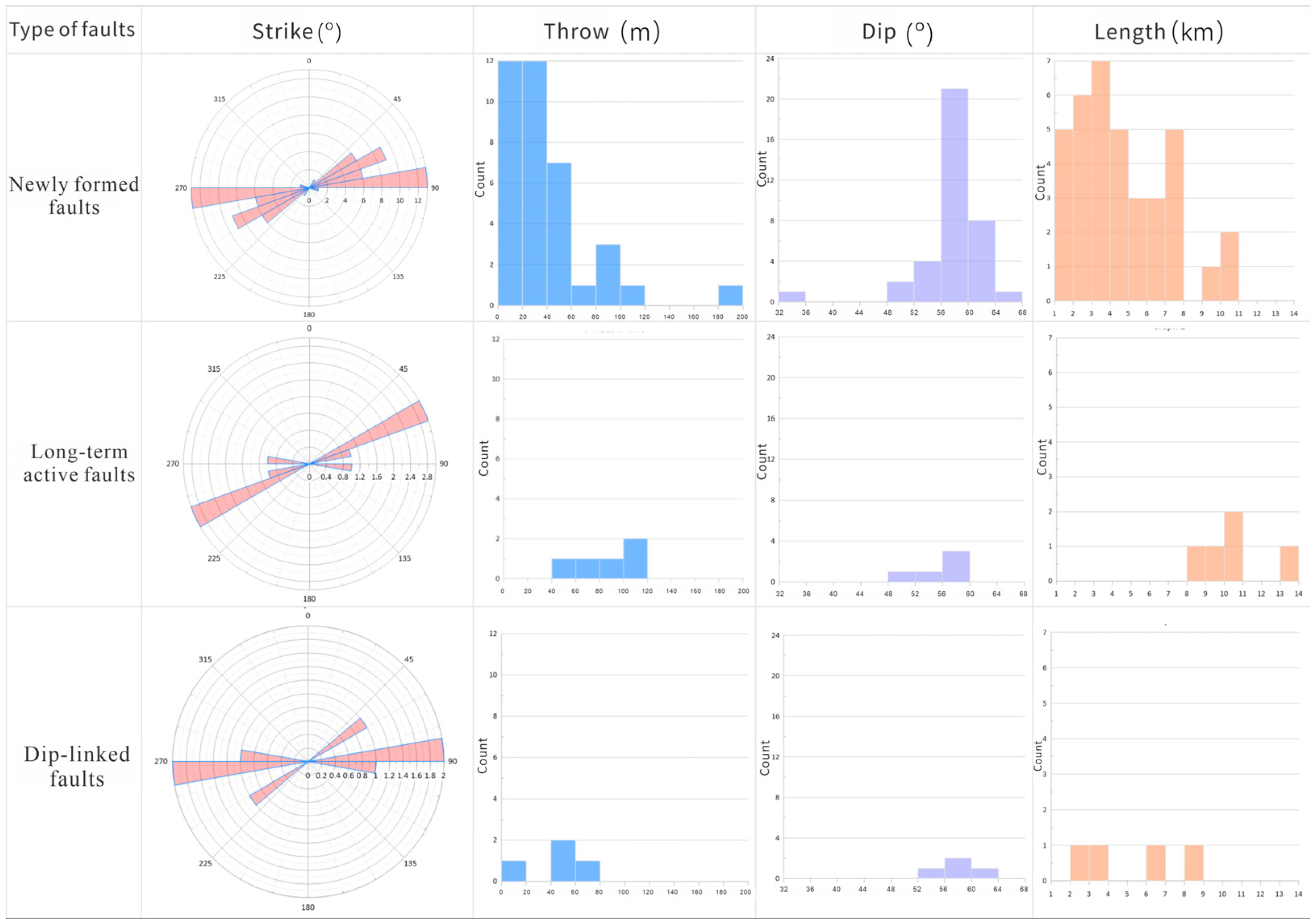

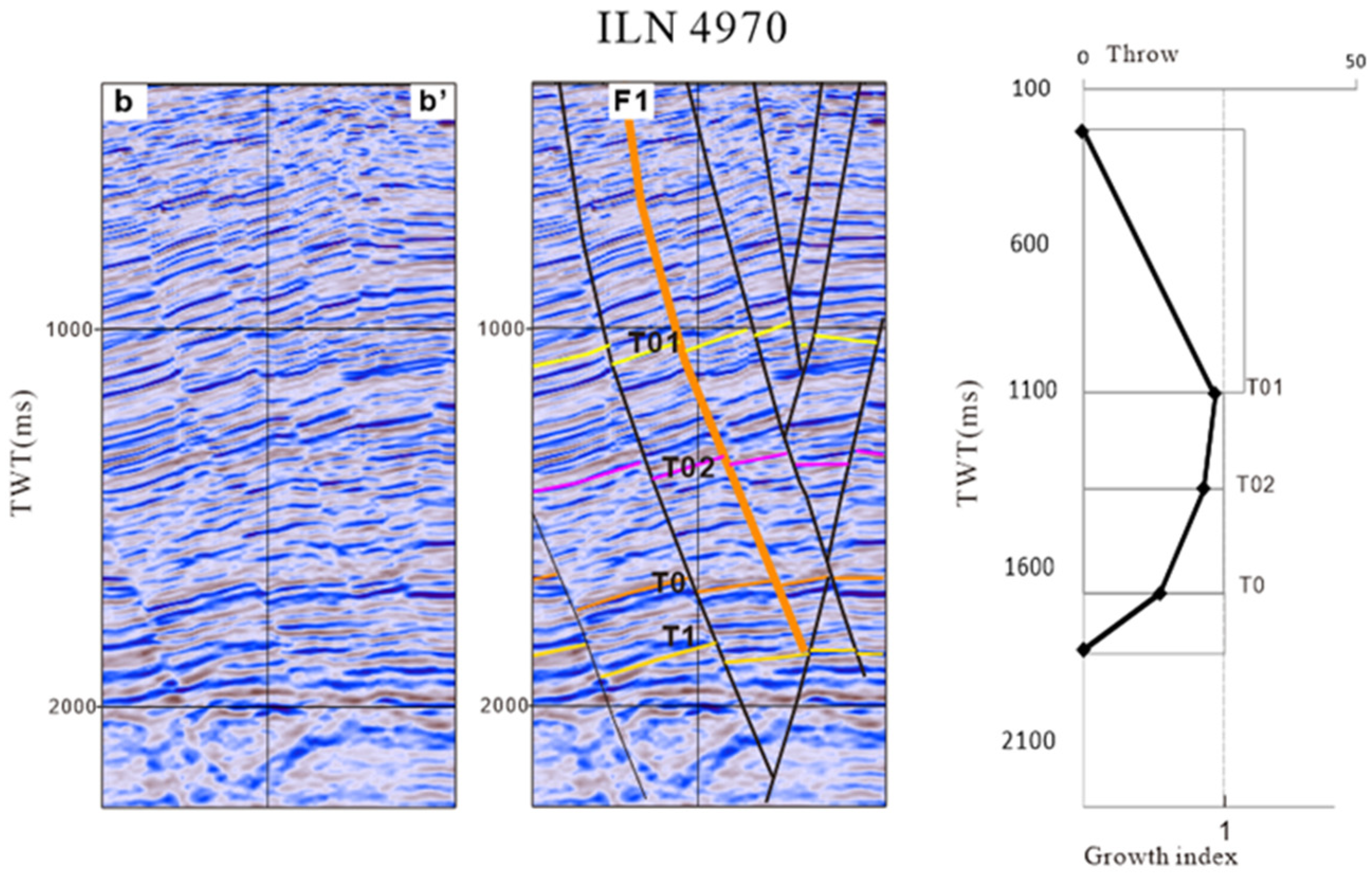
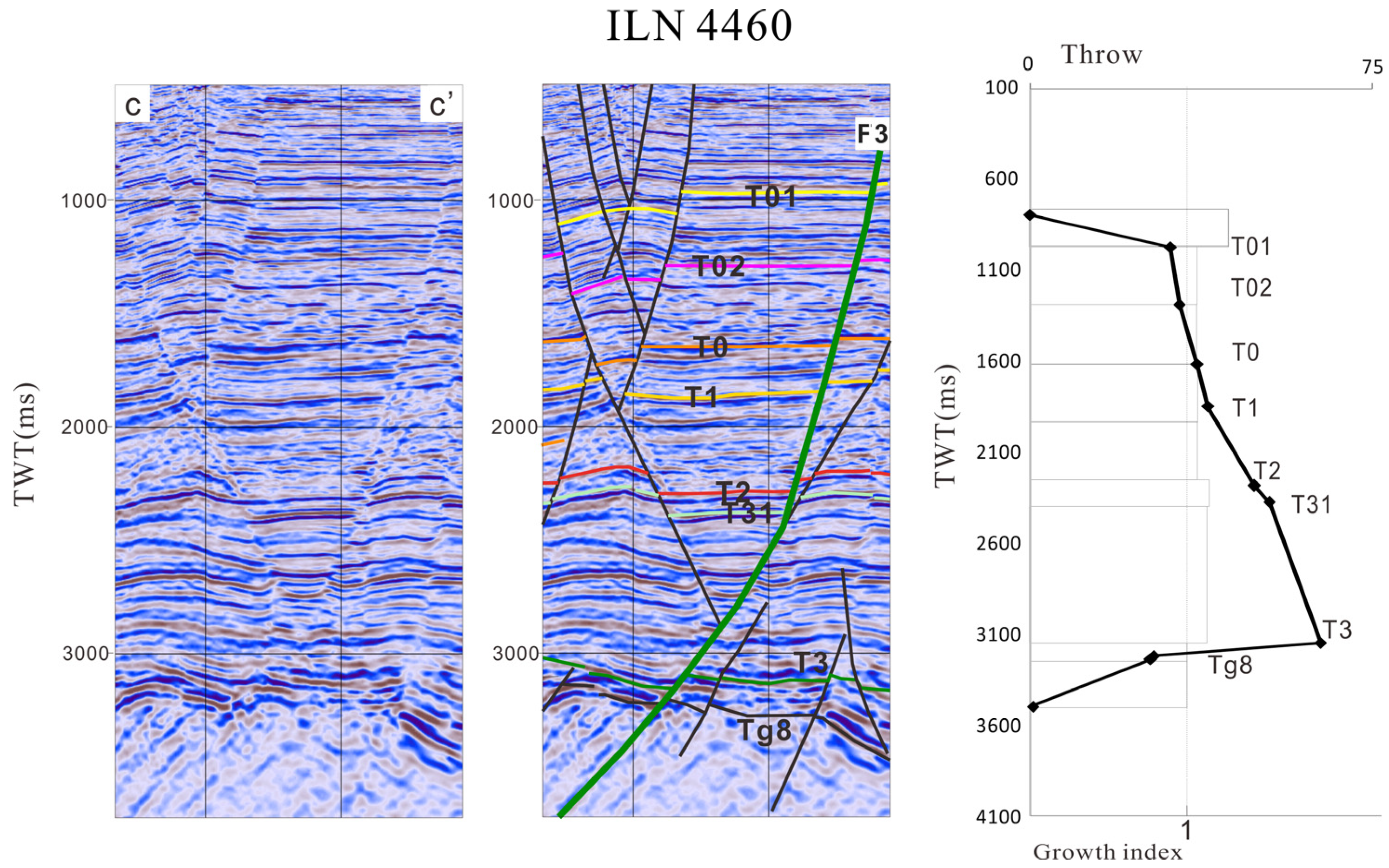
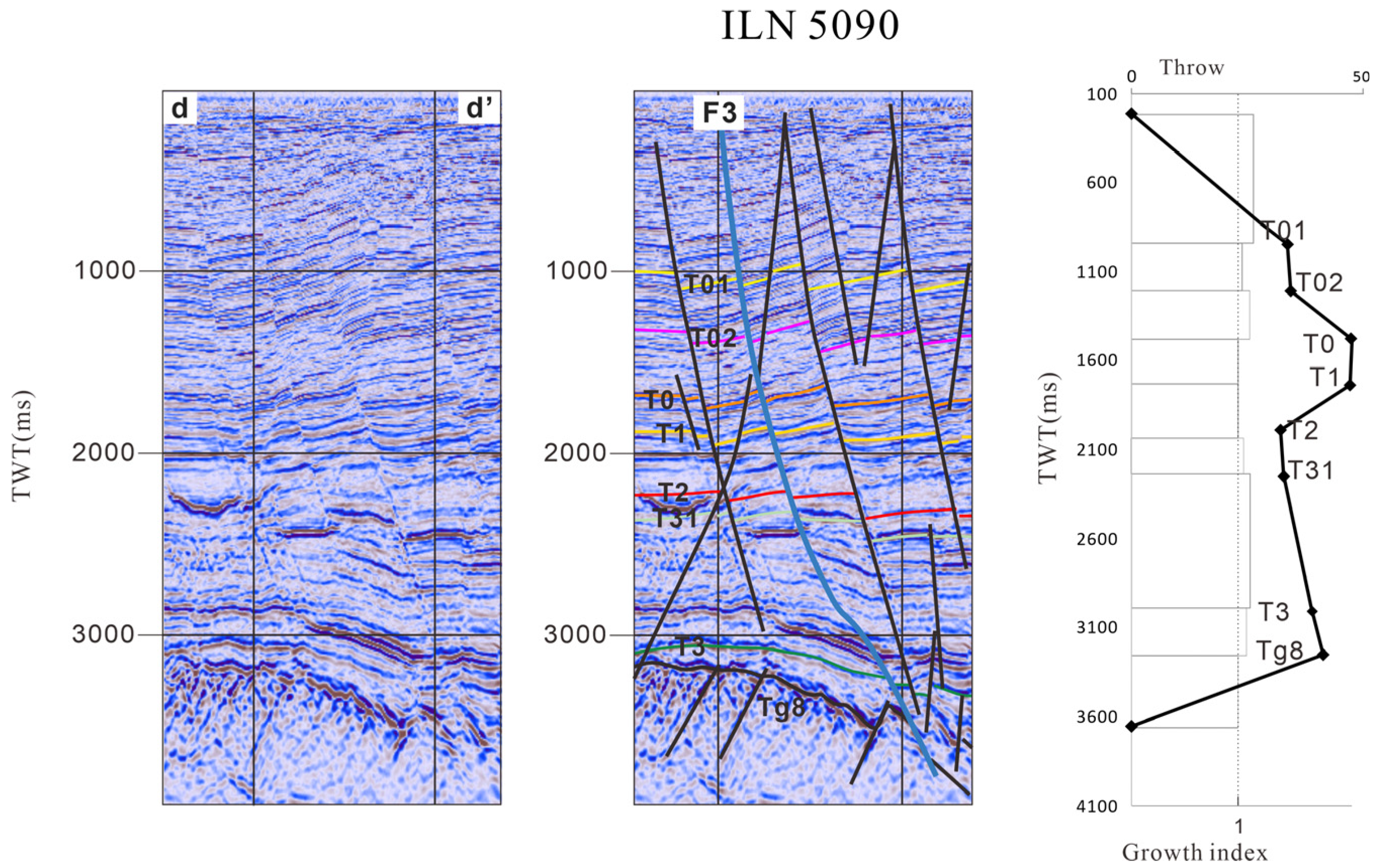
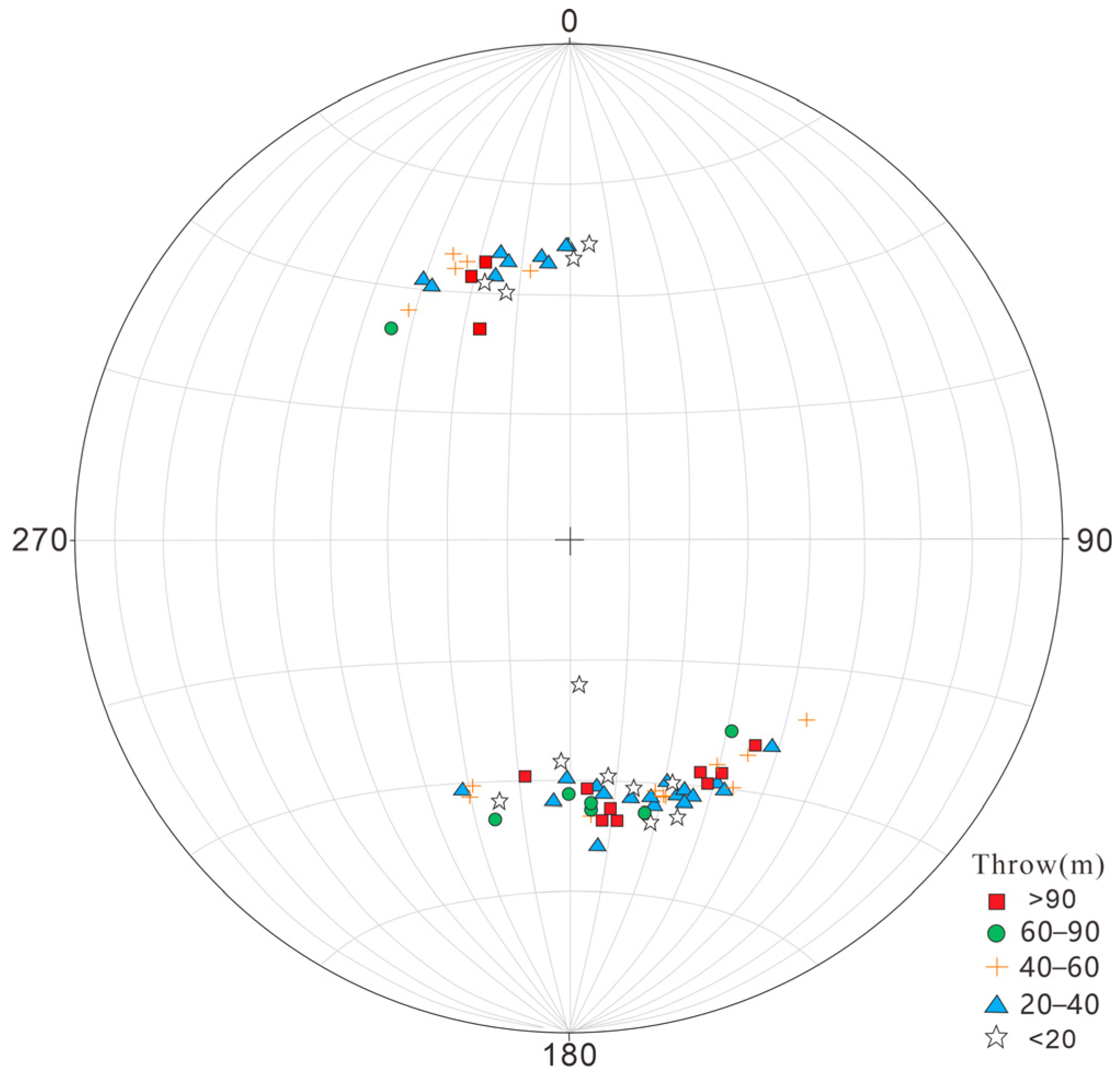
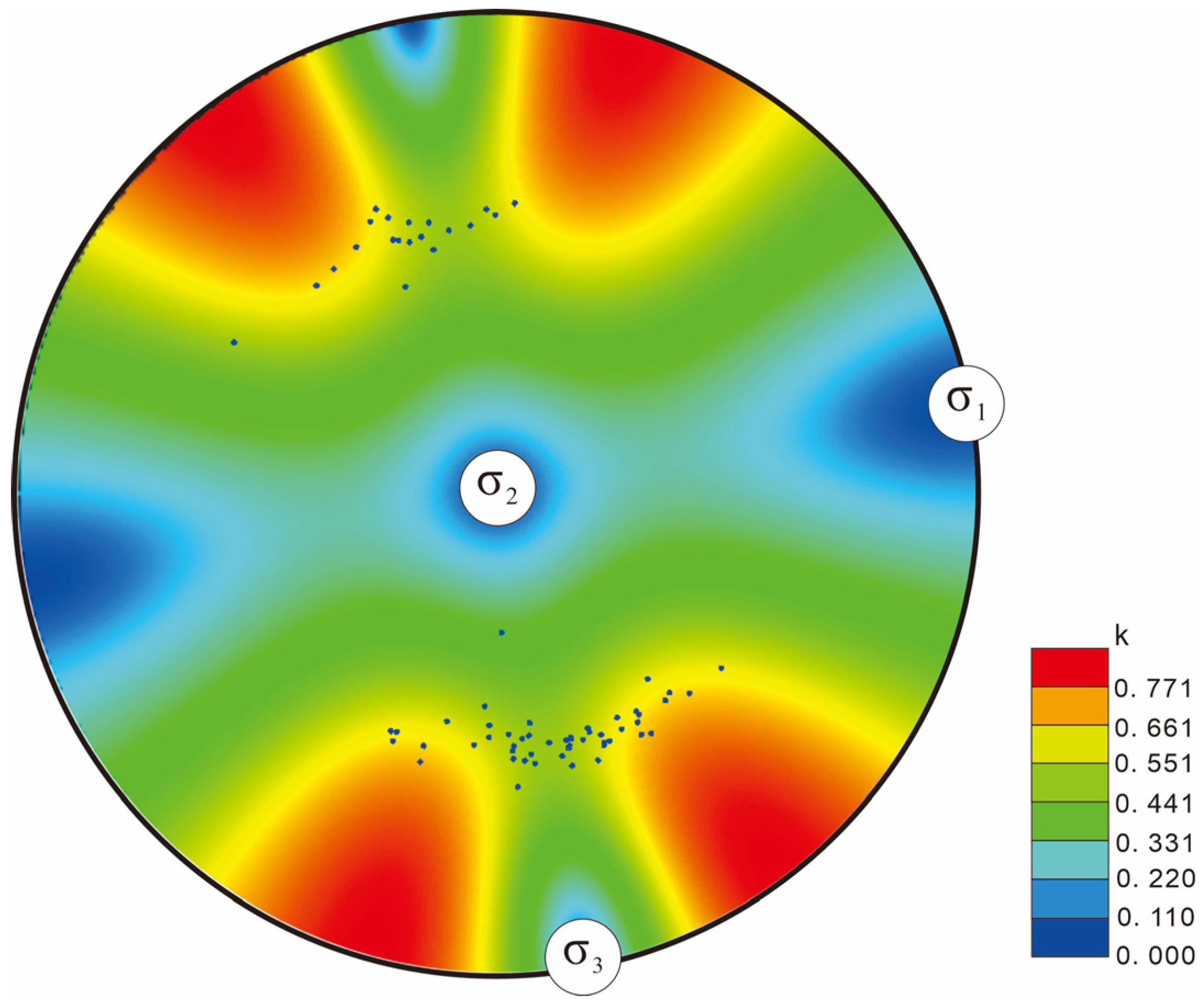
Disclaimer/Publisher’s Note: The statements, opinions and data contained in all publications are solely those of the individual author(s) and contributor(s) and not of MDPI and/or the editor(s). MDPI and/or the editor(s) disclaim responsibility for any injury to people or property resulting from any ideas, methods, instructions or products referred to in the content. |
© 2025 by the authors. Licensee MDPI, Basel, Switzerland. This article is an open access article distributed under the terms and conditions of the Creative Commons Attribution (CC BY) license (https://creativecommons.org/licenses/by/4.0/).
Share and Cite
Yang, S.; Li, X.; Wang, K.; Ping, G. Developmental Characteristics of Post-Rift Faults and Palostress Field Inversion in the Bozhong 19-6 Structural Belt. Processes 2025, 13, 2726. https://doi.org/10.3390/pr13092726
Yang S, Li X, Wang K, Ping G. Developmental Characteristics of Post-Rift Faults and Palostress Field Inversion in the Bozhong 19-6 Structural Belt. Processes. 2025; 13(9):2726. https://doi.org/10.3390/pr13092726
Chicago/Turabian StyleYang, Shuchun, Xinran Li, Ke Wang, and Guidong Ping. 2025. "Developmental Characteristics of Post-Rift Faults and Palostress Field Inversion in the Bozhong 19-6 Structural Belt" Processes 13, no. 9: 2726. https://doi.org/10.3390/pr13092726
APA StyleYang, S., Li, X., Wang, K., & Ping, G. (2025). Developmental Characteristics of Post-Rift Faults and Palostress Field Inversion in the Bozhong 19-6 Structural Belt. Processes, 13(9), 2726. https://doi.org/10.3390/pr13092726




